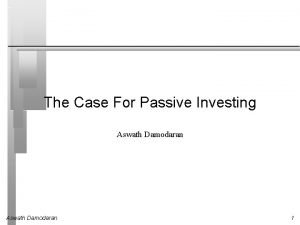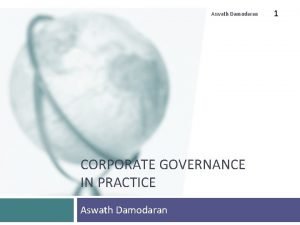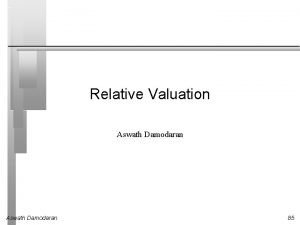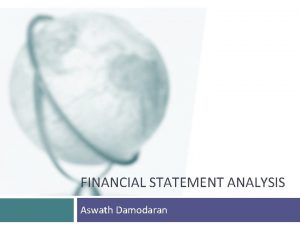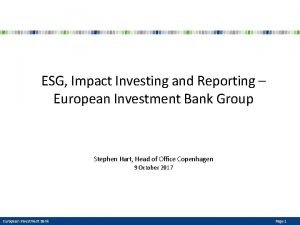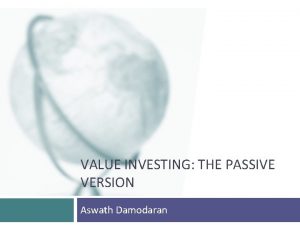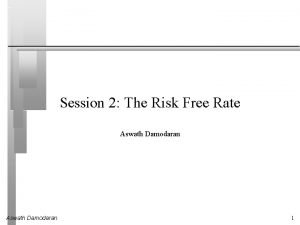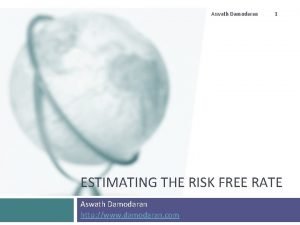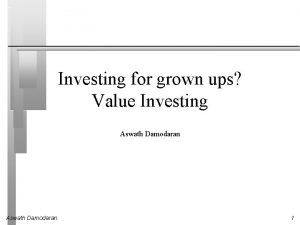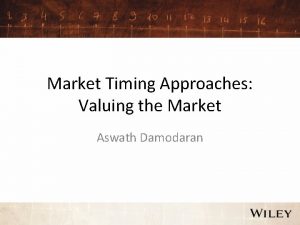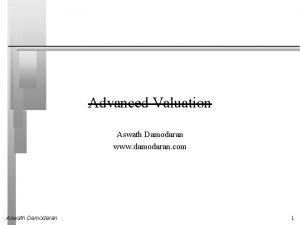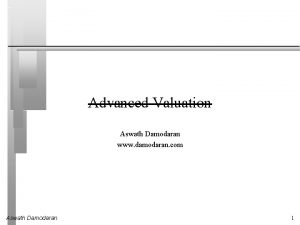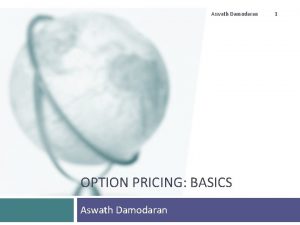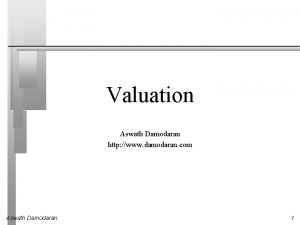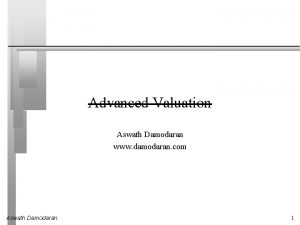MARKET TIMING APPROACHES VALUING THE MARKET Aswath Damodaran















- Slides: 15

MARKET TIMING APPROACHES: VALUING THE MARKET Aswath Damodaran

Valuation Approaches Just as you can value individual stocks with intrinsic valuation (DCF) models and relative valuation (multiples) models, you can value the market. If you have faith in your market valuations, you would view it as under valued if it is at a level lower than predicted by your intrinsic or relative value models. 2

I. Intrinsic Value: Valuing the S&P 500 On January 1, 2011, the S&P 500 was trading at 1257. 64 and the dividends plus buybacks on the index amounted to 53. 96 over the previous year. On the same date, analysts were estimating an expected growth rate of 6. 95% in earnings for the index for the following five years. Beyond year 5, the expected growth rate is expected to be 3. 29%, the nominal growth rate in the economy (set equal to the risk free rate). The treasury bond rate was 3. 29% and we will use a market risk premium of 5%, leading to a cost of equity of 8. 29%. (The beta for the S&P 500 is assumed to be one) 3

Valuing the market Following the same thesis that the value of a business (stock) is the present value of the cash flows on that business (stock), you can value the entire market. To value the market, you have to Estimate expected cash flows from buying the entire market in future years. If you are looking at an equity index, these cash flows have to be to equity investors. Assess a rate of return that you believe is a fair rate of return on stocks collectively, by adding a “fair” equity risk premium to a risk free rate. 4


6

How well do intrinsic valuation models work? Generally speaking, the odds of succeeding increase as the quality of your inputs improves and your time horizon lengthens. Eventually, markets seem to revert back to intrinsic value but eventually can be a long time coming. There is, however, a significant cost associated with using intrinsic valuation models when they find equity markets to be overvalued. If you take the logical next step of not investing in stocks when they are overvalued, you will have to invest your funds in either other securities that you believe are fairly valued (such as short term government securities) or in other asset classes. In the process, you may end up out of the stock market for extended periods while the market is, in fact, going up. The problem with intrinsic value models is their failure to capture permanent shifts in attitudes towards risk or investor characteristics. This is because so many of the inputs for these models come from looking at the past. 7

Relative Valuation Models • • • In relative value models, you examine how markets are priced relative to other markets and to fundamentals. While it shares some characteristics with intrinsic valuation models, this approach is less rigid, insofar as it does not require that you work within the structure of a discounted cashflow model. Instead, you either make comparisons of markets over time (the S&P in 2019 versus the S&P in 1990) or different markets at the same point in time (U. S. stocks in 2019 versus European stocks in 2019). 8

0, 00% 1960 1961 1962 1963 1964 1965 1966 1967 1968 1969 1970 1971 1972 1973 1974 1975 1976 1977 1978 1979 1980 1981 1982 1983 1984 1985 1986 1987 1988 1989 1990 1991 1992 1993 1994 1995 1996 1997 1998 1999 2000 2001 2002 2003 2004 2005 2006 2007 2008 2009 2010 2011 2012 2013 2014 2015 2016 2017 2018 US Stocks: E/P Ratios , T. Bond Rates and Term Structure over time 9 EP Ratios, and Interest Rates: 1960 -2018 16, 00% 14, 00% 12, 00% 10, 00% 8, 00% 6, 00% 4, 00% 2, 00% -2, 00% E/P Aswath Damodaran T. Bond Rate T. Bond minus T. Bill 9

There is a relationship, but it is noisy and changing… 10 Correlation between E/P and interest rates In the following regression, using 1960 -2018 data, we regress E/P ratios against the level of T. Bond rates and a term structure variable (T. Bond - T. Bill rate) EP Ratio = 0. 0376 + 0. 5325 T. Bond Rate - 0. 1595 (T. Bond Rate - T. Bill Rate) (5. 84) (6. 22) (-0. 78) R squared = 41. 97% Going back to 2008, this is what the regression looked like: E/P = 2. 56% + 0. 7044 T. Bond Rate – 0. 3289 (T. Bond Rate-T. Bill Rate) (4. 71) (7. 10) (1. 46) R squared = 50. 71% The R-squared has dropped and the differential with the T. Bill rate has lost significance. How would you read this result? Aswath Damodaran 10

2. Comparisons across markets 11

Example : Emerging Markets: June 2000 12 12

Regression Results The markets that trade at low PE ratios also have high interest rates and high country risk. To control for those differences, I regressed PE ratios on these variables– PE = 16. 16 - 7. 94 Interest Rates + 154. 40 Growth in GDP - 0. 1116 Country Risk R Squared = 73% 13 13

Predicted PE Ratios 14 14

Determinants of Success at using Fundamentals in Market Timing • This approach has two limitations: – – • Since you are basing your analysis by looking at the past, you are assuming that there has not been a significant shift in the underlying relationship. As Wall Street would put it, paradigm shifts wreak havoc on these models. Even if you assume that the past is prologue and that there will be reversion back to historic norms, you do not control this part of the process. . How can you improve your odds of success? – – You can try to incorporate into your analysis those variables that reflect the shifts that you believe have occurred in markets. You can have a longer time horizon, since you improve your odds on convergence. 15
 Damodaran
Damodaran Aswath damodaran age
Aswath damodaran age Aswath damodaran startup valuation
Aswath damodaran startup valuation Aswath damodaran multiples
Aswath damodaran multiples Damodaran value investing
Damodaran value investing Aswath damodaran
Aswath damodaran Aswath damodaran accounting 101
Aswath damodaran accounting 101 Aswath damodaran esg
Aswath damodaran esg Pbv
Pbv Aswath damodaran value investing
Aswath damodaran value investing Damodaran default spread
Damodaran default spread Risk free rate aswath damodaran
Risk free rate aswath damodaran Aswath damodaran multiples
Aswath damodaran multiples Damodaran statistics
Damodaran statistics Damodaran discount rates
Damodaran discount rates Damodaran
Damodaran
